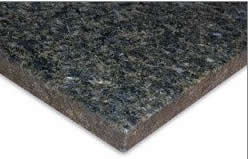
Figure 1 - Granite countertop
Granite is a natural stone that has flaws within its surface. These flaws allow liquids to penetrate the surface of the granite and leave stains that are next to impossible to remove. The liquid products that we use every day in cooking, tomato sauces, wine, and oils to mention only a few can leave a granite countertop looking ugly days after it has been installed.
Splatter from frying pans and placing cooking utensils on granite countertops are two of the most common ways to have stains set in the granite.
There are two basic types of granite sealers:
- Granite Surface Sealers:
- Granite Penetrating Sealers:
A granite surface sealer sits on top of the granite and acts similar to the polyurethane that is put on floors, as shown in Figure 2.

Figure 2 - Surface sealer on granite
Note: The granite surface sealer is a clear liquid. It has been colored orange in the diagram in order to provide the reader with a visual indication of how the sealer performs.
A granite surface sealer works well when it is applied. However, as the countertop is cleaned on a day-to-day basis, the surface sealer is worn off. Hence there is no longer any protection for the granite countertop.
A penetrating sealer actually fills in the voids in the granite. As its name implies, it penetrates the granite and fills any voids that exist in the natural stone, as shown in Figure 3.

Figure 3 - Penetrating sealer on granite
Even if the surface of the sealer is worn off from day-to-day cleaning the sealer has filled the voids in the granite and hence liquids cannot penetrate the granite and leave stains.
Although substantially more expensive, I highly recommend the use of a penetrating granite sealer over a granite surface sealer as the initial sealing product.
You can use a granite surface sealer every year or so, depending on countertop usage, to further protect and replenish sealer that has been worn off by cleaning and general usage.
How To Use a Granite Penetrating Sealer:
Note: These are general recommendations for applying a penetrating granite sealer. Always follow the manufacturer’s instructions for their specific product.
There are three common mistakes made when applying a granite penetrating sealer.
- Applying the sealer after the faucet and sink have been installed. The granite countertop should have the penetrating sealer applied prior to installing any plumbing fixtures. If you install the plumbing fixtures prior to applying the penetrating sealer, the penetrating sealer cannot seal the areas under the sink rim or under the faucet plate.
- Applying the sealer when there is construction dust in the air. Once the sealer is applied it will remain tacky for a period of time, any dust that settles on the penetrating sealer will adhere to the sealer.
- Applying the sealer to a countertop that is still wet. Prior to applying the granite penetrating sealer the granite countertop must be washed. A common mistake is to dry the granite using a dish towel or paper towel. However, as the granite is somewhat porous, moisture will remain in the voids in the granite. It takes time for this moisture to evaporate. If you apply the sealer to a granite countertop while the voids are filled with moisture the penetrating sealer cannot fill those voids and hence will not thoroughly protect the granite countertop.
The granite penetrating sealer should be applied to the exposed edge areas of the faucet pipe holes and to the exposed edge of the sink.
Allow the countertop to dry for 24 hours prior to applying the granite penetrating sealer.
Selection of granite countertop sealers
